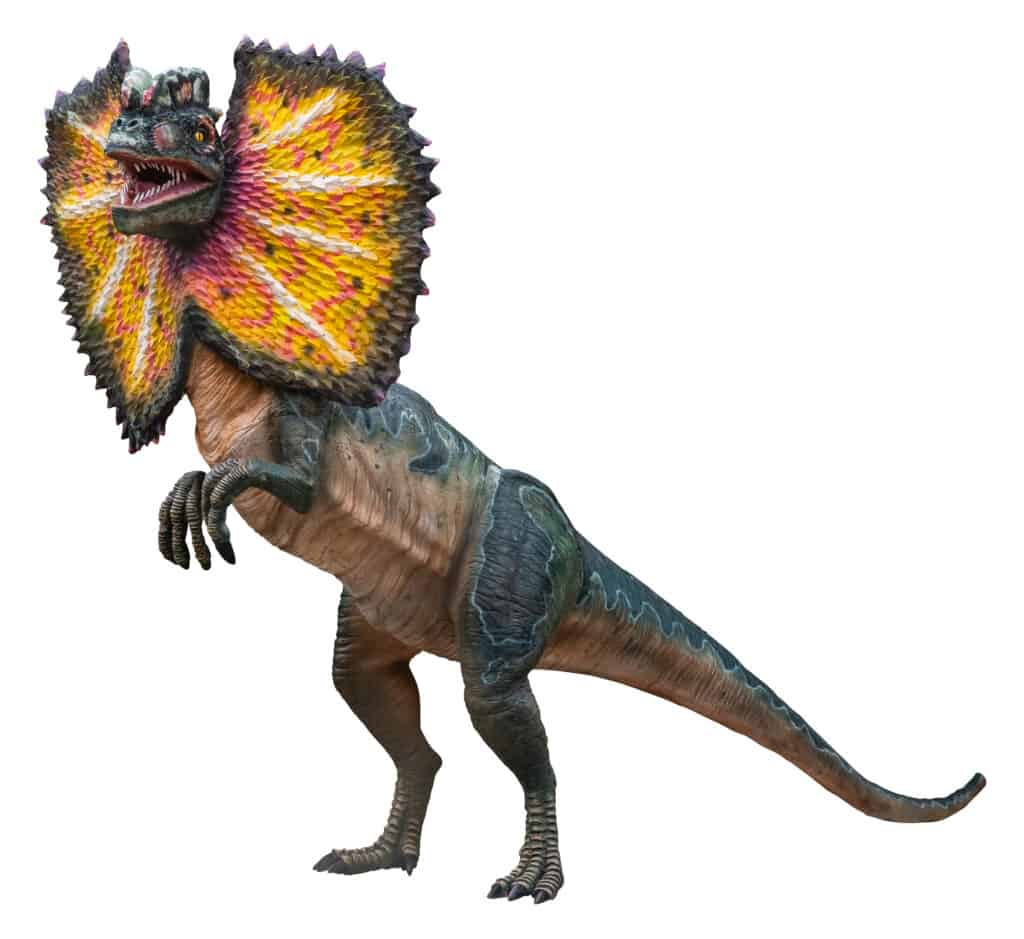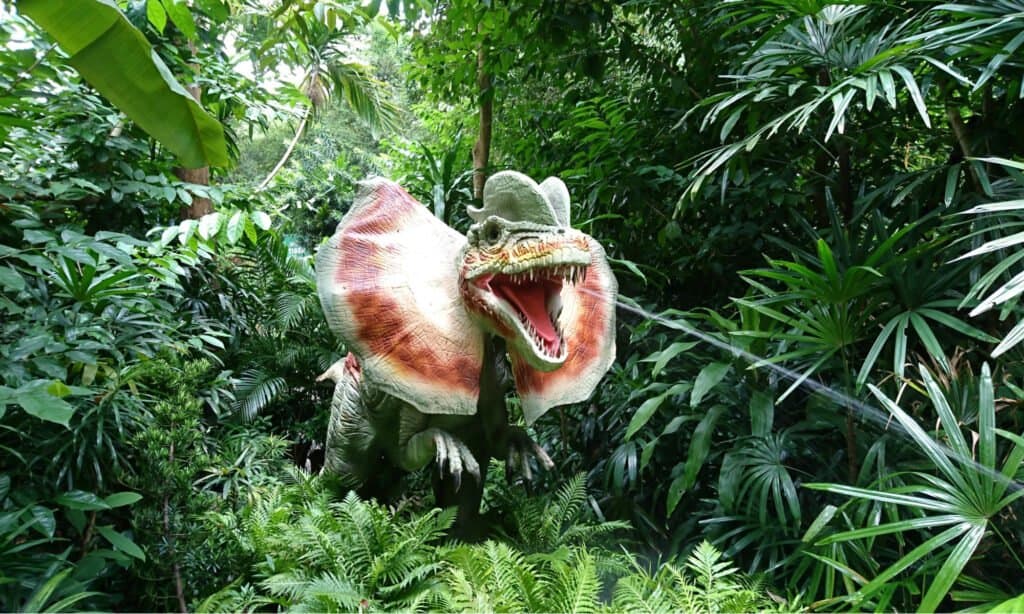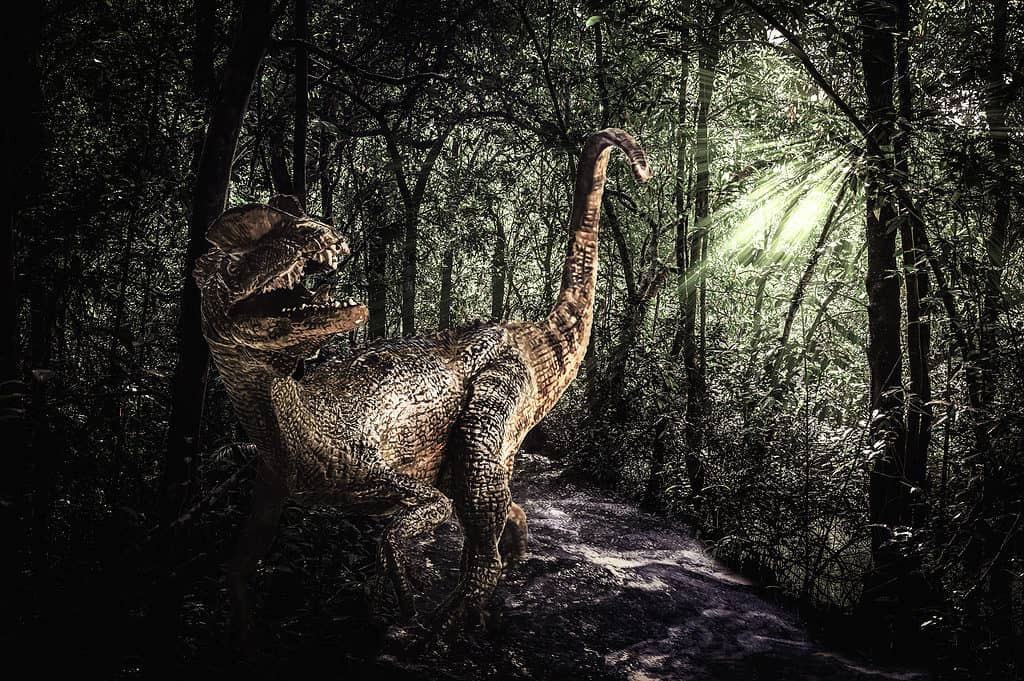Anyone who watched Jurassic Park, which came out in 1993, no doubt remembers the imposing, terrifying dinosaurs, who rendered the surrounding humans powerless.
We know that in reality, dinosaurs and humans have never existed at the same time. However, watching the two interact was definitely a memorable experience for anyone who has seen the movie.
No doubt that viewers of the movie remember the famous acid-spitting dinosaur, a rendition of the very real Dilophosaurus that existed during the Jurassic era. If you were enamored by this creature, read on to learn more about it!
Jurassic Park’s Version of the Dilophosaurus

Unfortunately, there is no evidence that the Dilophosaurus could spit venom, as seen in 1993’s
Jurassic Park.
©YuRi Photolife/Shutterstock.com
Of course, the way that this creature was portrayed was absolutely fascinating. However, the truth is that some of the major features that you remember about the Dilophosaurus were not accurate.
You may have been in awe when you saw the Dilophosaurus spitting venom, for the purpose of paralyzing and blinding its prey. However, you may also be disappointed to know that the acid-spitting dinosaur, in real life, couldn’t do this. In fact, there’s no evidence that there’s any dinosaur who was able to do this.
Also, in the movie, the Dilophosaurus had a neck frill. According to scientific evidence, including fossils, this neck frill did not exist in the real Dilophosaurus. The director of the movie created it to make the dinosaur appear scarier.
The creature in the movie was a predator, whereas the real-life Dilophosaurus was likely a scavenger. It was also much larger in real life than the version portrayed in the movie. In the movie, it was about the size of a large dog.
Why Was Jurassic Park’s Dilophosaurus Inaccurate?

Researchers have learned a great deal about the Dilophosaurus since its portrayal in
Jurassic Park.
©Cheng Wei/Shutterstock.com
The truth is that in 1993, knowledge about the Dilophosaurus was very incomplete. However, in the almost 30 years since the portrayal of this creature in the movie, researchers have discovered a lot of new information. This information shows that the portrayal of this dinosaur in the movie was very inaccurate, more so than any other creature portrayed in Jurassic Park.
In 1954, when the Dilophosaurus first made its appearance in the scientific world, University of California – Berkeley paleontologist Samuel Welles thought it was a new species in the established Megalosaurus genus.
However, when he learned more about the top of the skull, including the dual skull crests that were characteristic of the animal, he realized that it was a new genus. He then renamed it Dilophosaurus wetherilli.
For the most part, the body plan of the Dilophosaurus in the movie was modeled after Welles’s anatomical depictions and museum reconstructions. However, the filmmakers made some modifications for their own cinematic purposes.
The most obvious departure from the true Dilophosaurus anatomy was the size of the creature in the movie. It was significantly smaller. The filmmakers did this on purpose so that the viewers would not confuse the Dilophosaurus with the Velociraptor.
The acid-spitting mechanism is based on some modern cobra species, which are able to spit their venom up to about two meters in distance. The neck frill was inspired by the frilled agamid lizard in New Guinea and Australia. The filmmakers added these features for dramatic effect. They were also somewhat believable since the features actually existed in modern animals.
Meet the Real-Life Dilophosaurus!

Despite not having the ability to spit venom, the Dilophosaurus is still an imposing, awesome creature worth studying.
©iStock.com/Kitti Kahotong
Even though the real-life Dilophosaurus didn’t spit acid, that doesn’t mean it’s not worth learning about. This creature was absolutely fascinating in its own right, even without the ability to spit venom at its prey.
Where and When Did the Dilophosaurus Live?
This dinosaur lived in the early Jurassic period (201.3 million years ago to 174.1 million years ago), approximately 190 million years ago. Scientists have found fossils in the United States. Specifically, they found three skeletons of this animal in Arizona.
Anatomical Features of the Dilophosaurus
The Dilophosaurus was about 23 feet (7 meters) long, and it weighed about 880 pounds (400 kilograms). It was the largest land animal in North America in that time period. This animal was a large theropod.
The skull of this animal was fairly large in comparison to the body, but delicate. It had a narrow snout with a small kink below the nostril, in the upper jaw. It’s possible that this kink served a purpose in catching prey. Modern crocodiles have a similar feature, which they use to grip and hold on to prey during the attack.
The Dilophosaurus had long, thin curved teeth. These teeth were smaller in the lower jaw than in the upper jaw. Most teeth had serrations as well. The Dilophosaurus had a long neck with light, hollow vertebrae. The animal also had powerful arms and hands with four fingers each. The thigh bones were very large, with stout feet and large claws on the toes.
Another prominent feature in the appearance of this animal is a pair of thin bony crests on top of the head. They were not prominent enough to play a role in battle. It is possible that the dinosaur used them simply for visual display, including sexual selection and recognition of the species.
Behavior of the Dilophosaurus
The Dilophosaurus was a carnivore. Conflicting reports make it unclear whether this animal was a predator or a scavenger, however. Scientists believe that the animal used the front teeth to capture and manipulate small prey animals and the larger teeth in the back to slice and kill the weakened animal. The Dilophosaurus likely fed on smaller animals, possibly including fish.
In 2021, scientists showed that the Dilophosaurus likely had unidirectional airflow through its lungs, similar to the breathing mechanisms of birds and crocodiles. These breathing patterns are associated with high metabolic rates and high activity levels. This suggests that this animal was a fast and agile hunter.
The common belief is that the Dilophosaurus moved on two legs. The animal likely used the forelimbs more as weapons against prey animals than for locomotion. This animal was likely capable of gripping and holding prey between the two hands, bringing it to their mouths with their hands, and performing a variety of other hand movements.
Up Next…
- Meet the 7 Most Famous Dinosaurs From Jurassic Park
- Meet Every Dinosaur Featured in Jurassic World Dominion (30 Total)
- Dinosaurs
The photo featured at the top of this post is © iStock.com/Kitti Kahotong
Thank you for reading! Have some feedback for us? Contact the AZ Animals editorial team.







